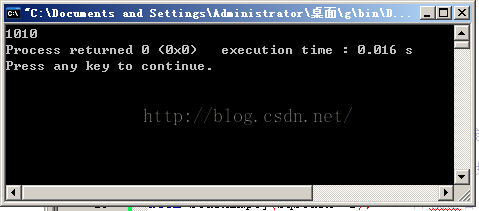第六周项目四-数制转换
/*文件名称:main.cpp
作者:王超
完成日期;2015年10月12日
版本号;v1.0 */
#include <stdio.h>
#include "sqstack.h"
int main()
{
MultiBaseOutput(10, 2);
return 0;
}
#include <stdio.h>
#include <malloc.h>
#include "sqstack.h"
void MultiBaseOutput (int number,int base)
{
//假设number是非负的十进制整数,输出等值的base进制数
int i;
SqStack *S;
InitStack(S);
while(number) //从右向左产生base进制的各位数字,并将其进栈
{
Push(S,number%base); //将将余数进栈
number/=base;
}
while(!StackEmpty(S)) //栈非空时退栈输出
{
Pop(S, i);
printf("%d",i);
}
}
void InitStack(SqStack *&s)
{
s=(SqStack *)malloc(sizeof(SqStack));
s->top=-1;
}
void DestroyStack(SqStack *&s)
{
free(s);
}
int StackLength(SqStack *s) //返回栈中元素个数——栈长度
{
return(s->top+1);
}
bool StackEmpty(SqStack *s)
{
return(s->top==-1);
}
bool Push(SqStack *&s,ElemType e)
{
if (s->top==MaxSize-1) //栈满的情况,即栈上溢出
return false;
s->top++;
s->data[s->top]=e;
return true;
}
bool Pop(SqStack *&s,ElemType &e)
{
if (s->top==-1) //栈为空的情况,即栈下溢出
return false;
e=s->data[s->top];
s->top--;
return true;
}
bool GetTop(SqStack *s,ElemType &e)
{
if (s->top==-1) //栈为空的情况,即栈下溢出
return false;
e=s->data[s->top];
return true;
}
void DispStack(SqStack *s) //输出栈
{
int i;
for (i=s->top;i>=0;i--)
printf("%c ",s->data[i]);
printf("\n");
}
#include <stdio.h>
#include <malloc.h>
#define MaxSize 100
typedef int ElemType;
typedef struct
{
ElemType data[MaxSize];
int top; //栈指针
} SqStack; //顺序栈类型定义
void MultiBaseOutput (int number,int base);
void InitStack(SqStack *&s); //初始化栈
void DestroyStack(SqStack *&s); //销毁栈
bool StackEmpty(SqStack *s); //栈是否为空
int StackLength(SqStack *s); //返回栈中元素个数——栈长度
bool Push(SqStack *&s,ElemType e); //入栈
bool Pop(SqStack *&s,ElemType &e); //出栈
bool GetTop(SqStack *s,ElemType &e); //取栈顶数据元素
void DispStack(SqStack *s); //输出栈
